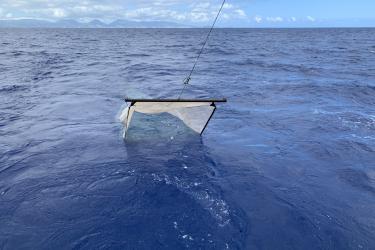Roosters crow as the sun peaks over the Ko‘olau mountain range and illuminates the greens and blues of Kane‘ohe Bay. A group of marine science researchers and water safety experts prepares the boats for a day on the water, gathering dry bags, personal flotation devices, and various safety equipment. Ulu Keaunui, a lifeguard from Ocean Safety, backs the jet ski off the trailer and slides it gently into the water. Alexa Gonzalez, a biological science technician with the Pacific Islands Fisheries Science Center, ties a SAFE Boat to the dock so the rest of the crew can load in equipment. The day is calm with light winds—a perfect day for training. I am attending the training as an onlooker, providing a helping hand when needed and documenting the day’s activities.
This Advanced Coxswain Training course is an equivalent to the Standards of Training, Certification, and Watchkeeping Fast Rescue Boat course. It is a requirement for launching, recovering, and operating boats from NOAA’s fleet of research ships. Recently, the Pacific Islands Fisheries Science Center partnered with the City and County of Honolulu Ocean Safety and the Honolulu Fire Department to conduct this class. The three different agencies are working together to teach the course and provide feedback to each other from their different perspectives.
Chad Yoshinaga, the safety and training coordinator and lead instructor for the Pacific Islands Fisheries Science Center comments on the unique training partnership: “The collaboration is valuable here, working with Ocean Safety and the Honolulu Fire Department,” Yoshinaga tells us, “because we can share our techniques and it makes each training program and each team better.”
“We can really adapt our rescue techniques, and our general operational techniques to the specifics of what we deal with in the Hawaiian Islands,” he says.
Pacific Islands scientists are dealing with a lot of different variables, including work in some of the most remote areas in the world in the Papahānaumokuākea National Marine Monument. Each year, scientists live and work on these remote atolls of the Northwestern Hawaiian Islands and they must be self-sufficient and able to self-rescue. So that is where this training comes in.
The course teaches victim recovery, fast-rescue boat techniques, search pattern procedures, surf navigation, and survival techniques. Students must be able to capsize and reright a boat—not an easy task in a shallow surf zone. The entire course culminates in what is known as a “mass casualty exercise,” where the team safely recovers multiple victims from the water. I played victim during one of these exercises and was very impressed by how the boat teams worked together, communicated effectively, and ultimately would have saved my life, had it been a real emergency.
Ian Forester of Ocean Safety speaks fondly of the work he has been doing with NOAA over the past 6 years: “We have been coordinating and learning from each other to help improve what we do and help improve what they do. It’s been a great collaboration.”
Forester assists Yoshinaga in instruction during the course, focusing on Ocean Safety’s specialty: victim recovery. “Communication is so important because we all do something a little different,” he explains. “It allows us to grow and build our skills and we can learn from each other.”
The students of the course see the value of this collaborative training as well. “ACT is a great course that taught us how to apply basic small boat and rescue skills to a variety of adverse situations that may arise in the field,” says student Alexa Gonzalez. “The collaboration of NOAA with the Honolulu Fire Department and Ocean Safety during the course was greatly appreciated and beneficial. It was awesome to hear feedback and tips from other organizations that are regularly involved in emergency situations.”
As we prepare for a busy season conducting research out in the field, these Pacific Islands Fisheries Science Center staff are fully trained and prepared for whatever comes their way.





